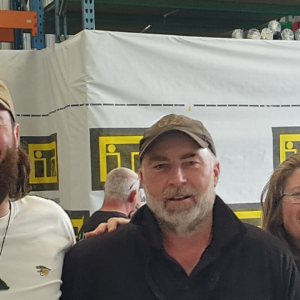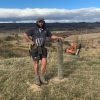
Ralph, the family dog – a massive Leonberger, was the inspiration behind Andrew and Ingrid McCracken’s Upper Hutt-based Big Dog Fencing.
“Ralph was awesome but had no respect for gardens. He was one of these big dogs that liked to make his mark on fences everywhere – so we called ourselves Big Dog Fencing. Our byline is ‘Leaving our mark on New Zealand’.”
Andrew started off erecting deer fencing in the 1980s with Frank Map in the Bay of Plenty.
“An amazing fencer, about 5 foot 2 and like a little bulldog. He was 65, and I couldn’t keep up with him as a 20-year-old.”
When Frank retired, the demand for deer fencing was still going and Andrew’s work grew. Set up with a Kinghitter bulldozer and a rammer on the back – he was in his element for a time until he drifted into a music and broadcasting career. Five years ago, he returned.
“Just before Covid, I went back to fencing. I just needed to get back to the land, and I am happy as hell.”
Andrew has a tight crew: Sean, Graeme, and Ingrid. They chug through an ever-changing list of projects: farms, lifestyle properties, forestry, and the odd job for companies across the greater Wellington region. They are currently completing the Level 4 Certificate in Fencing course, working toward becoming an Accredited Fencing Contractor with FCANZ.
HUHA, an animal rescue and shelter on Haywards Hill in rural Wellington, is a regular feature on the whiteboard.
What kind of deer fencing do you want?
Andrew says a year into Big Dog, he got a phone call from Jim, HUHA Operations Manager. “Jim asked if I did deer fencing. I said, ‘What kind of deer fencing do you want?”
“It wasn’t deer fencing that they needed, but it was deer fencing in height. They wanted dog-proof paddocks, down to a dog the size of a terrier. We ended up fencing with X Fence, top-to-bottom solid security fencing made by Summit Steel.”
X Fence is usually designed to go on flat land but parts of the HUHA block up off Transmission Gully are incredibly steep. The slope varies up and down 30-degrees.
“We cut the netting out, strain it back up and crimp it up tight. We might go 10m, then we have to do it again. Then another 30m and have to do it again. It is a bit like being a seamstress.”
Something that has made work at Big Dog Fencing a bit easier is a SoloNet dispenser. It’s a digger-mounted wire dispenser that lets the crew pick up and run big coils of wire and run it through a grab.
“You wire it off your first strainer and you can lift it over a strainer off the edge of a track and then pull it and clamp it tight with a digger, put tension meters on it and then staple it off. Then you can run it down the next bit of fence line. Imagine pulling a piece of cellotape. We wired up six-days of fencing, 600m, in a day and a half. I came home and said to Ingrid – ‘That thing’s not leaving!’”
The whole menagerie: deer, pigs, birds, dogs, lizards, turtles, guinea pigs
Since then, Big Dog Fencing has done three kilometres of X Fence and have turned their hands at all sorts: Post and rail fence for a small horse area for a mare with a blind foal, a fenced turtle and lizard enclosure and a current project building three barracks for 300 rescued guinea pigs.
“They asked the other day if we could turn the gully into an aviary. You just don’t know what will be next. As long as it’s a little bit like fencing, we will give it a go.”
Quite a lot of research and design work goes into delivering some of the unusual requests, looking at different products and pricing up jobs. And some jobs come up in winter that really should be tackled in summer. Because HUHA rescues animals or they have animals dumped on them, like after the Port Hill fires or when the cyclone hit in the Hawke’s Bay, jobs happen when they are needed.
Land, water, people and animals meet at the fence line
Andrew says the hardest thing is putting up something that animals will not destroy.
“HUHA are not interested in running electric outriggers on fences. So, that is a challenge.”
Instead, the crew avoids fencing across hillsides, where the animals can undermine the integrity of a fence very quickly. The work-around is to carve out a wide track, put the fence down the middle with a good flat space either side.
“If animals do track the fence line, they tend to wear holes where water runs down. You need to create drainage under the fence line and fence those off or put grills to cross the pipes. If you put a decent sized pipe in, it is just an escape route. If animals are undermining the fence, we come back with the digger, heap the soil, pack it and hope that it doesn’t happen again. It’s a lot like trying to beat the ocean.”
Another challenge is when animals get up close and personal. Most rescue animals have been raised by humans at some point and can be quite interested in people.
“They have a donkey, Franklin, he’s an orphan. He’ll steal the drills off your belt and run across the paddock. Then, their ostrich, who is not quite so friendly, he’ll stick his head in the ute door and steal the keys out of the four-wheel drive and stalk up behind you.”
The animals always have the right of way. That’s who HUHA are. They are all about the animals. So, it is a fine line between getting frustrated with the animals and trying to fence them in.”
They are also thinking about access ways into enclosures — that health and safety separation element.
The fifteen or so great big old sows and Kunekune are a good example. They’re quite fond of the sloppy hops donated from the local Panhead Brewery. While hay and other dry feed could be delivered over the fence, the slop needs to be carted and tipped from wheelbarrows – but if the volunteers open the paddock gate, there’s a good chance that some pigs “half the size of a small cow” could make an escape. So Big Dog Fencing are building walkways through the pig paddocks.
“Sometimes Sean will say, ‘I like seven wire and batten fence’— and I say, ‘This is good experience, you might never get asked to do this again’.”
HUHA Helping you help animals
Carolyn Press McKenzie, CEO of HUHA says, when it comes to fencing on the 157 acre sanctuary on the Haywards Hill property, they have a clean slate.
“We have an opportunity to do it once and do it right. We are lucky to have Andrew. We know he’ll build something that will last the distance.”
HUHA’s mission is all about protecting animals, many different species, but it is also about protecting the people who are working around them, or even just visiting them.
“We have to bring all those components together to build something that is going to work for the visitors, the workers and the animals as well – and then there’s the environment too.”
Carolyn says rescued animals are not always well socialised, some feel vulnerable and prone to panic and the X Fence predator fencing “tiny wee squares” provides a level of confidence.
“Having something that contains the animals well is very important, but you also don’t want people poking their fingers in or climbing in. We rescue deer and other animals that can be unpredictable, so we need to keep people out as much as we keep animals in.”
Andrew and his crew have just built an internal fence inside paddock fencing at HUHA so that the workers have something to leap over and stand behind if something becomes a little edgy.
Carolyn says HUHA had a big pig problem recently. “We had 30 free-range pigs come our way, we didn’t want to euthanise them, but we didn’t have the facilities. Andrew fenced off two acres of scrappy bush. It was quite a mission.
Today, Andrew is fencing around a great big turtle pond. “Turtles can compromise the environment, and they are great climbers. Andrew is building a stacked three-tier retaining wall and then a fence on top with a cap going inward. It is really important when you take in animals, that you make sure that they don’t get back out.”
Next week, Andrew will be coming back to build dog enrichment areas. He will be doing four large fenced off sections with a retaining wall so that the dogs in HUHA’s care can go out and play in small social groups.
Carolyn says enclosure design is all about experience, Kiwi ingenuity, good common sense and amazing problem solving strategies – but another layer for HUHA is speed.
“We do disaster response. We go all over the country when there is an emergency, so we have to build containment facililities that are temporary to get animals safely contained quickly. That’s our job. Coming home, it is the same mindset. We have to achieve safety for people and animals, we just have to unpack it and work it out.”
There’s extra touches that Big Dog Fencing adds, from helping design structural builds that are a little tangent to traditional fencing, to making sure the camber of the road is right. Carolyn says it is holistic approach. “Everything is considered.”
Article written by Megan Fowlie
Published in WIRED issue 73/JUNE 2024 by Fencing Contractors Association NZ
Follow us on Facebook
© Fencing Contractors Association NZ (FCANZ)
















